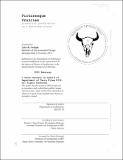Picturesque prairies : productive preservation on a petroleum planet
Author(s)
Swingle, Tyler R
DownloadFull printable version (85.87Mb)
Other Contributors
United States. Department of Terra Firma.
Advisor
Joel Lamere.
Terms of use
Metadata
Show full item recordAbstract
Fires burn bright atop the flare stacks in the distance as bison watch from behind the two-meter high fence of the Theodore Roosevelt National Park. In this modern scene, complex geographic formations in North Dakota's badlands have established a unique shared topography between an assemblage of seemingly disparate actors: engines, bison and humans. The Bakken formation 6 km below the surface of the earth provides enough resources to encourage rhizomatic deployment of oil and gas wells while the sedimentary surface, eroded from melting snow, provides 'scenic' lands for tourists and prairie ecosystems for bison. The socio-political distinction between actors has produced abstract borders and delineations in the form of habitats and land-use policies. Materialized through fences, these policies have created autonomous operating systems like fracture drilling and wildlife conservation that are specified for a single or hierarchical order of actors. This not only facilitates settler practices of separation and domination, but also encourages unaccountable externalities outside of the operating systems. Located between two [and a half] National Park units, this project embraces the multiple identities of the subterranean region and proposes a design strategy that engages the three actors as equal shareholders. Acknowledging the actors as an assemblage reveals material kinships and commitments to the geography that offer design considerations for shared spaces and memories. The project is composed of three archetypes, each weaving and entangling the actors within each other's programs and seasonal patterns. Through this built environment, the archetypes frame a physical and conceptual shared geography
Description
Thesis: M. Arch., Massachusetts Institute of Technology, Department of Architecture, 2018. This electronic version was submitted by the student author. The certified thesis is available in the Institute Archives and Special Collections. Cataloged from student-submitted PDF version of thesis. "Permit Proposal 2018.01.18." Seal of the Department of Terra Firma, United States of America printed on title page. "Permit Proposal: Maah Daah Prairie; Plains to Ports Partnership. This document was produced, edited and printed by the U.S. Department of Terra Firma under the Plains to Ports Partnership in cooperation with the state of North Dakota"--Page 7. Includes bibliographical references (pages 161-163).
Date issued
2018Department
Massachusetts Institute of Technology. Department of ArchitecturePublisher
Massachusetts Institute of Technology
Keywords
Architecture., United States. Terra Firma.